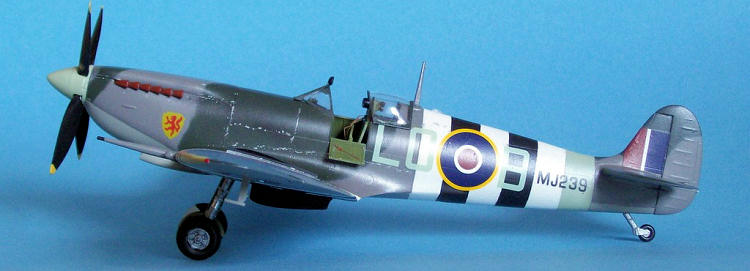
| KIT #: | 48079 |
| PRICE: | CAD$33.98 |
| DECALS: | Three options |
| REVIEWER: | Pablo Calcaterra |
| NOTES: | Victory Productions 48006, Aeromaster 48-237 and Condor Decals (Argentinos en la RAF) 48012 |

| HISTORY |
Ken Charney
Historical Background:
Kenneth Langley Charney was born in
Quilmes, Argentina, in 1920. Ken was Angloargentinean. His father had been a
soldier in World War I and now was manager of the Anglo Mexican Petroleum Co.
Because of this, his family moved from one city to another within the country.
When he was 12, he was speeding in his father’s car and was caught by the police
of
As one of his father’s responsibilities
was to refuel the planes of Aeroposta in
To complete his studies he was sent to
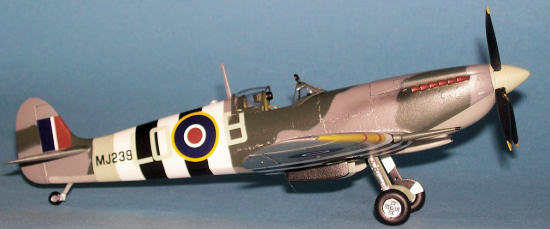 When war broke, Ken left for the
When war broke, Ken left for the
He got his wings in April 1941 as a
Sergeant Pilot and his first Squadron was 91, where he flew for 14 months.
He was recommended as flight commander
and sent to
A very famous plane from
On
The loss and suffering of so many young
friends changed his spirit and he became sad and depressed.
Early 1943 saw him posted to 53
Operational Training Unit where he became famous for his skills as an
instructor. After much struggling, he managed to get away from this “boring”
place and during the second half of 1943 he served in 122 Squadron, where he
stayed for some weeks.
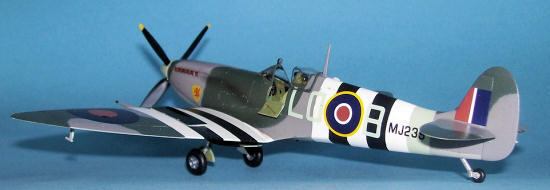 In November 1943 he was transferred to
602 “City of
In November 1943 he was transferred to
602 “City of
Clostermann says that Ken had a great
heart and was always ready to laugh and play jokes on others.
They flew escort missions to Hurry
bombers, Flying Fortresses, intruders’ missions, the mission against the
Munsterland, rangers…
On
In July 1944 he was promoted to Squadron
Leader.
Ken would go to London and meet with
other Argentines in pubs and other common places for his co-nationals.
Flying over Falaise, he was the first to
spot the German 7th Army trying to escape. He called on the radio:
“Send out whole Air Force!” The massacre at Falaise had started.
When he left 602 Sqn he was posted to 132
Sqn. They had Spit IX which were used to attack the V1 sites. He got 2 more
victories in this Squadron. The last one of his tally happened this way: Nine
Germans were detected flying above the Spits and Ken sounded the alarm. When
they dove on the British, the Spits split in pairs and the Argentine got on the
tail of a Fw190. This one turned sharply but Ken got his tail again and fired a
burst that made the Fw190 explode. This was his 7th and final
confirmed kill (to be added to 4 probable and 8 damaged).
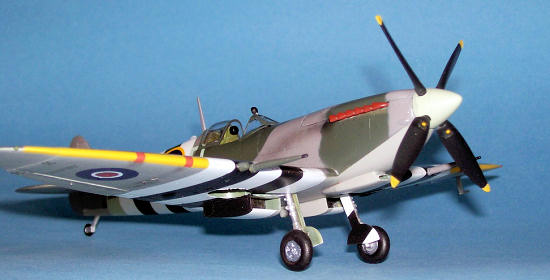 They were sent to the Far East, where
they flew Spitfire VIII and then XIVs in Madura. Aboard HMS Smitter 132 RAF
Squadron to settle in Hong Kong after the Japanese surrender. His Spit was named
Jean
They were sent to the Far East, where
they flew Spitfire VIII and then XIVs in Madura. Aboard HMS Smitter 132 RAF
Squadron to settle in Hong Kong after the Japanese surrender. His Spit was named
Jean
After the war he became part of Lord
Louis Mountbatten’s staff. He was liaison with the Indonesian and Malayans, as
he knew their languages. Then he was named Commanding Officer of RAF Palembang
and in 1947 he was transferred to Ceylon.
He became an instructor in 1950, when he
flew Vampires in Sylt, Germany. He witnessed the tests of atomic bombs on
Christmas Island in 1959 as he was on those days Wing Commander on the Task
Force.
In 1960 he was in charge of the RAF Cadet
School in London and later on he was in charge of the forces in Christmas Island
(Army, Navy and Air Force).
He retired as Group Captain in 1970. He
became an Instructor in the Saudi Air Force for 3 years, lived in Spain for a
short time and finally set to live in Andorra. During his career he had flown 36
types of planes and had 2,300 hours in jets and fighters.
He loved to sky, golf, music and
photography.
He married in 1980 and had no kids. He
died of cancer in 1982.
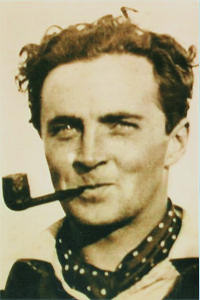
|
Date |
Enemy |
Place |
Sqn |
|
01 Jul 42 |
MC202 probable |
Malta |
185 |
|
06 Jul 42 |
Bf109 probable |
Malta |
185 |
|
12 Jul 42 |
MC202 confirmed |
Malta |
185 |
|
27 Aug 42 |
Ju 88 probable |
Comiso |
185 |
|
27 Aug 42 |
Ju 88 damaged |
Comiso |
185 |
|
05 Sep 42 |
Bf109 confirmed |
Zonkor |
185 |
|
13 Oct 42 |
Bf109 probable |
Malta |
185 |
|
15 Oct 42 |
Mc202 confirmed |
Malta |
185 |
|
17 Oct 42 |
Mc202 damaged |
Kalafrana |
185 |
|
17 Oct 42 |
Ju 88 damaged |
Comiso |
185 |
|
23 Oct 42 |
Bf 109 damaged |
Dingli |
185 |
|
14 Jan 44 |
Fw 190 confirmed |
St. Pol |
602 |
|
23 Jun 44 |
Bf 109 probable |
Caen |
602 |
|
02 Jul 44 |
Fw 190 confirmed |
Cabourg |
602 |
|
02 Jul 44 |
Fw 190 probable |
Cabourg |
602 |
|
13 Jul 44 |
Fw 190 damaged |
Cabourg |
132 |
|
13 Jul 44 |
Bf 109 damaged |
Lisieux |
132 |
|
13 Jul 44 |
Fw 190 confirmed |
Lisieux |
132 |
| THE KIT |
No information provided, but visit this link for a preview.
| CONSTRUCTION |
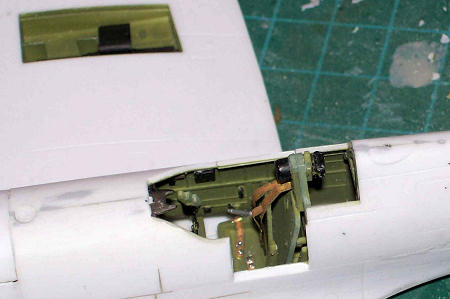 I have read that there are some
inaccuracies with the
I have read that there are some
inaccuracies with the
I painted the interior of the kit many years ago but left it aside. Last year I decided to start building not only planes from the Malvinas war, but also planes flown by other Argentines, the ones that flew with the RCAF and RAF in World War II. So I tackled this kit.
Honestly, there is not a lot to be said. This kit really goes together very well. As the pictures show, there was practically no putty required anywhere. It is a pleasure to build, on par with the Tamigawa kits. As I did not put the engine supplied with the kit, I made a backup to hold the engine exhausts in place (these were painted in rust before gluing them in place). The screens of the radiators were painted in black and highlighted in aluminum.
When the plane was built, minus the
landing gear, I started to paint it.
| COLORS & MARKINGS |
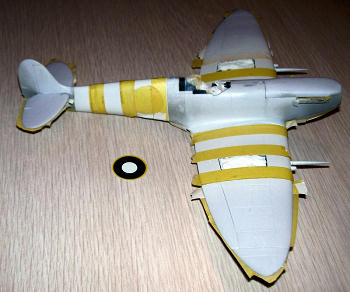 I first painted the white ID bands used
in Normandy and using the roundel for the fuselage, I masked it (9 mm wide) to
later on paint the black bands. I used the roundel as a template because in the
past I have found that some decals don’t have enough color density and then the
black shows thru. So by making the white paint with the roundel diameter, I was
just preventing this situation. More about this later…
I first painted the white ID bands used
in Normandy and using the roundel for the fuselage, I masked it (9 mm wide) to
later on paint the black bands. I used the roundel as a template because in the
past I have found that some decals don’t have enough color density and then the
black shows thru. So by making the white paint with the roundel diameter, I was
just preventing this situation. More about this later…
Then I painted the underside in Acryl
Modelmaster 4759. After masking it, I went for the top camo: green (Acryl
Modelmaster RAF Dark Green) and gray color (Vallejo 991), using blue tac for the
delimitation lines. With the entire
plane now covered in a thin plastic bag, I sprayed the Sky band (Modelmaster
4840) on the fuselage and the nose. The black sections of the ID bands, the
propeller and wheels were next.
Dark Green) and gray color (Vallejo 991), using blue tac for the
delimitation lines. With the entire
plane now covered in a thin plastic bag, I sprayed the Sky band (Modelmaster
4840) on the fuselage and the nose. The black sections of the ID bands, the
propeller and wheels were next.
I dry brushed black pastel for stains
here and there, and a silver pen was used to mark some panels and chipped paint.
A very sharpened pencil was used to highlight moveable surfaces.
There were not retouches required, and I went for the coats of Future.
Decals:
Like always, I start with the stencils
and leave the more colorful ones for last. The
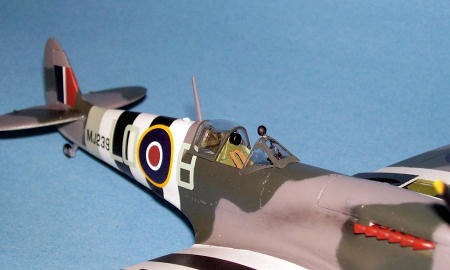 Then I went for the roundels. Here I used
the Victory Productions ones. Great ink density. Several hands of Set and Sol
made them fit perfectly on the model.
Then I went for the roundels. Here I used
the Victory Productions ones. Great ink density. Several hands of Set and Sol
made them fit perfectly on the model.
When the moment came for the fuselage
roundel, I discovered that not only the decals are excellent, but also that I
had masked the roundel in the wrong position! So I painted with a brush the
white round area where needed and the day after I applied the decal. The same
mistake happened on both sides. I don’t know what I was thinking on when I made
the original masks…
The Victory Productions flashes for the
fin are OK but the decals are very thick and not very flexible…I had to glue (!)
the front part of the decal as it kept on unfolding (not following the contour
of the front part of the vertical part of the tail) even after several layers of
Set and Sol.
The letters came from the Aeromaster set,
though the “B” is not exactly the correct type based on profiles of this Spit
that I have found in a couple of books.
The serial number and the 602 badge came
from Condor Decals which went with no problem at all. But I realized that the
area around the badge should have had green cammo instead of gray. I had made a
mistake when I masked this area…too late. Modelers, beware!
The red patches that cover the machine guns were cut from red decals I found in the spares box.
| FINAL CONSTRUCTION |
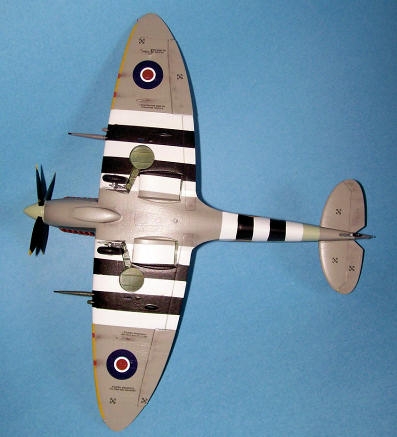 With all the decals in place, I glued the
gun sight, windshield and back part of the canopy, wheels, wheels doors,
propeller subassembly (fixed), antenna, and lights here and there (painting the
ones on the wing tips in red and green and the white navigation one on the
rudder). Finally, I glued the access door open and placed the hood in the open
position.
With all the decals in place, I glued the
gun sight, windshield and back part of the canopy, wheels, wheels doors,
propeller subassembly (fixed), antenna, and lights here and there (painting the
ones on the wing tips in red and green and the white navigation one on the
rudder). Finally, I glued the access door open and placed the hood in the open
position.
| CONCLUSIONS |
I am very happy with this Spitfire. It
look like a nice Spitfire IX. It was very easy to build. It is my FIRST (more to
come) tribute to the Argentines that flew with the RCAF and RAF in World War II.
Thanks to Claudio Meunier for the help and the picture of Ken in Malta.
| REFERENCES |
Wings of Thunder, by Claudio Meunier and
Carlos Raimondi (an excellent resource to learn more about the little known
story of these volunteers)
The Big Show, by Pierre Clostermann
June 2010
If you would like your product reviewed fairly and quickly, please contact me or see other details in the Note to Contributors.